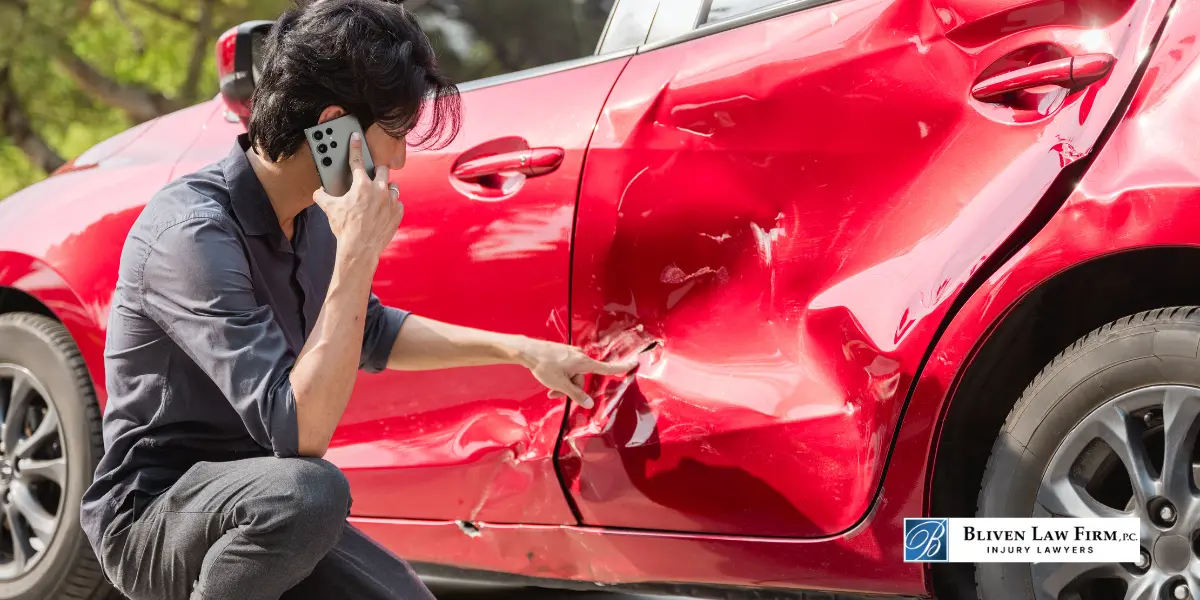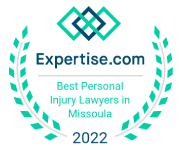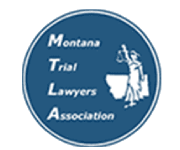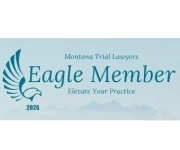Montana Car Accident Lawyer

Car Accident Attorney In Montana
Have you been injured in a car accident in Montana or Oregon? Do not rely on insurance companies to help you recover fair compensation. Let the experienced attorneys at Bliven Law Firm, P.C., help you obtain full, fair, and prompt compensation. Backed by more than 35 years of personal injury practice, our Montana car accident lawyer works hard to ensure the most favorable possible outcome for you and your family.
Why Trust Bliven Law Firm, P.C.?
The aftermath of a car collision can leave you seeking answers and accountability. The seasoned litigators at Bliven Law Firm, P.C., understand the regional legal landscape. This gives us insight into the nuances of each jurisdiction, which is crucial in addressing both common and unique challenges in accident claims. We know that motor vehicle accidents can cause serious and lasting injuries. On top of this, debt can pile up if you have to take time off work to nurse these injuries.
Additionally, medical expenses incurred from the accident will add another strain to your financial burden. Our legal team understands the full weight of these concerns. That is why we work hard to help you obtain advanced medical settlements, as well as other forms of compensation, including property damage recovery and potential future medical needs stemming from the accident.
Contact Us Today Bliven Law Firm, P.C.
Call Us Today:
406-755-6828
Common Causes of Car Accidents in Montana
Auto accidents involving two or more vehicles often occur due to negligence. According to the Montana Department of Transportation’s preliminary statewide crash report released in October 2023, 776 serious injuries were recorded across the state. In 2021, approximately 5,700 large trucks were involved in collisions that resulted in serious harm, while another 117,000 were linked to crashes that caused injuries.
Data also shows that the majority of Montana crashes, nearly nine out of 10, take place on rural roads, reflecting the higher risk of collisions outside urban areas. Negligent driving consists of any sort of reckless behavior taken while operating a motor vehicle.
When a driver’s negligent actions are the cause of an accident, they can be legally liable for damages. Additionally, regional factors, such as harsh weather conditions in these states, can exacerbate common negligence issues.
The most common forms of negligent driving involve:
- Driving while under the influence of alcohol or other controlled substances
- Failing to drive with appropriate caution in dangerous weather conditions
- Speeding
- Breaking traffic rules, signs, or signals
- Failing to yield the right of way
- Driving while distracted, such as when texting or otherwise using a cell phone
Steps You Should Take After a Car Accident
After a car crash, assess yourself and any other passengers for serious injuries that may need immediate attention. Then, call the police and, if needed, request medical emergency responders. When the police arrive, you will want to comply with their requests and answer their questions.
You need not discuss fault with the police; just give them the facts about what happened. Later, you will want to obtain a copy of the official police report for your records. Documenting the scene accurately by taking detailed notes can be beneficial, as memory may fade over time.
Our Montana car accident attorneys also recommend you collect evidence at the scene, including:
- Photos of the vehicles
- Photos of your injuries
- Documenting the point of contact
- Documenting the resultant damages
- Obtain witness information
If any eyewitnesses are available, collect their contact information and make sure they give their account of the event to the police. You will also want to exchange contact information with the other driver before you leave the scene. Gathering this information will help you later if you decide to pursue a claim. Organized records of all related documents, including car repair receipts, are essential in bolstering future insurance or legal proceedings.
Types of Car Accidents
The initial information that your attorney will want to know is how your car accident happened. These are extremely important to your case. At Bliven Law Firm, P.C., we know not to tackle every car accident the same way. Rear-end accidents often require different levels of investigation than head-on collisions.
In addition, head-on collisions often result in more serious injuries than side-swipe car crashes. This means that the type of car accident that caused your injuries is significant. Understanding these distinctions can help tailor the right legal strategy.
In general, five types of traffic collisions that can occur include:
- Rear-end accidents. These car accidents most frequently occur at traffic lights and stop signs. When drivers are distracted or are not paying attention, they can run into the driver in front of them. Rear-end accidents can cause significant injury to the head and neck, as well as soft tissues in the body.
- Head-on collisions. These are some of the most serious of all accidents. Head-on collisions often cause severe and life-threatening injuries and fatalities. Head-on collision accident victims often require significant compensation. Understanding the common factors, such as confused drivers, can be pivotal in establishing fault.
- Side-impact or T-bone crashes. This type of car accident often leads to life-threatening injuries. This is because the side of the vehicle is not designed to withstand high accident forces. When a car hits the side of another car, the driver and passengers are less protected from harm. These accidents often happen at intersections and can be linked to traffic signal violations or failure to survey the surrounding traffic adequately.
- Side-swipe accidents. Side-swipe accidents occur on highways and freeways when one car attempts to change lanes and runs into the car next to it. These accidents may or may not result in serious injury. However, side-swipe accidents can result in a car being pushed off the road and into a guardrail or oncoming traffic.
- Hit-and-run accidents. All drivers must stay at the scene of an accident that causes injury and damage. When a driver leaves the crash scene, they are guilty of committing a crime. While the police attempt to track down the hit-and-run driver, you will need an attorney looking out for you and your interests.
Challenges of Driving in Montana, Oregon
The geographic spread of Montana, with its vast open roads like those along US Route 93, presents unique challenges for drivers susceptible to accidents in isolated regions. Such areas can result in delayed emergency response times. Moreover, icy roads during Montana’s extended winters significantly increase the risk of collisions.
Oregon drivers often contend with heavy rainfall, leading to slick roads and decreased visibility. Areas such as I-5, a major artery, are notorious for congestion-related accidents. Both states also experience deer crossing incidents, which are a common hazard during certain times of the year.
Montana Law and Legal Rules
Understanding Montana’s legal framework is essential after a vehicle collision. Under Montana’s comparative negligence law (Mont. Code Ann. § 27-1-702), injured individuals may recover compensation even if they share partial fault, as long as their responsibility does not exceed 50%. Any damages awarded are reduced by the percentage of fault assigned to the injured party.
Under that legal framework, a driver found to be 10% at fault could still receive $18,000 from a $20,000 settlement or court verdict. The statute of limitations for filing a personal injury claim is three years from the date of the accident, according to Mont. Code Ann. § 27-2-204. Failing to file within that period generally bars recovery.
Montana also follows a mandatory auto insurance system under Mont. Code Ann. § 61-6-301, requiring all drivers to maintain liability coverage of at least $25,000 per person and $50,000 per accident for bodily injury, plus $20,000 for property damage. These laws work together to ensure accountability, protect accident victims, and provide a clear path toward financial recovery after a crash.
Injuries and Compensation
Car accidents in Montana can lead to a wide range of injuries, from minor cuts and bruises to catastrophic injuries. Whiplash and soft tissue injuries are common in rear-end collisions and often cause lasting neck and back pain.
Fractures and broken bones frequently occur when the force of impact crushes the vehicle frame. Traumatic brain injuries (TBIs) and spinal cord damage can result from high-speed or rollover crashes. These types of injuries can lead to paralysis or permanent disability.
Victims may also suffer from internal bleeding, burns, or lacerations caused by shattered glass and metal. Beyond the physical harm victims suffer, many experience emotional trauma, including anxiety, depression, or post-traumatic stress. Compensation can cover medical expenses, rehabilitation, lost income, pain, and suffering, which can help victims rebuild their lives after a devastating accident.
Why You Should Hire a Car Accident Lawyer
If you suffered injuries in Montana due to someone else’s negligence or wrongful acts, you have the right to pursue compensation with the help of a Montana car accident lawyer. Civil claims are handled at Flathead County District Court (920 South Main Street, Kalispell, MT 59901), Missoula County District Court (200 West Broadway Street, Missoula, MT 59802), and other civil courts, depending on which one has jurisdiction over your claim.
The decision to hire a Montana car accident lawyer allows you to benefit from their years of experience handling complex car accident claims. Montana’s car accident laws require plaintiffs to present compelling evidence to back up their injury claims. An attorney can play a key role in holding the negligent party accountable by gathering evidence and managing negotiations. Strong representation can ensure that you receive the compensation that you are owed.
FAQ’s
Should I Go to the Hospital After a Car Accident?
It is important to seek medical attention as soon as possible and follow up with medical treatment and advice. This is true even if you initially appear to be unharmed. Often, the adrenaline from being in a crash will prevent you from noticing injuries or pain. At the same time, many car accident injuries do not appear immediately. Instead, symptoms will develop days or weeks later. However, a medical professional can spot these injuries in an examination.
Keeping track of your medical records after a crash and during any treatments you undergo will protect your health and establish an essential record for potential injury claims.
What Does an At-Fault State Mean?
Every state has different laws regarding auto insurance claims. Some states use a fault-based system, while others are no-fault. Montana is an at-fault or tort state, which means the driver who caused the accident is responsible for compensating the injured driver for any damages. Oregon is also an at-fault state.
Understanding these laws is key to navigating the claim process effectively and ensuring proper evidence collection to substantiate fault. Insurance negotiations can be intricate, requiring knowledge of potential settlement traps like low initial offers.
What Should You Do if the Other Driver Is Uninsured?
If you’re in an accident with an uninsured driver in Montana or Oregon, the first step is to file a police report to document the incident officially. This report becomes critical in your dealings with your own insurance company. Check if your policy includes uninsured motorist coverage, which can provide compensation.
Additionally, consulting with an experienced attorney from Bliven Law Firm, P.C., is advised to explore further legal recovery options. Montana and Oregon laws provide avenues for seeking redress through the personal assets of the at-fault driver, though this can be a complex process requiring careful legal guidance.
How Long Do You Have to File a Claim After a Car Accident?
In Montana, the statute of limitations for filing a personal injury claim after a car accident is generally three years from the date of the incident. In Oregon, you typically have two years. It’s crucial to begin the claims process as soon as possible to preserve evidence, recollections, and witness statements.
Early action aids in constructing a more compelling and thorough account for the insurance company or any legal proceedings. Always consult with our legal team to clarify timelines and ensure compliance with all procedural requirements.
Secure the Compensation You Are Owed. Contact Bliven Law Firm, P.C., Today
A serious car accident can upend your life in an instant, leaving you with mounting medical bills and lasting uncertainty. A Montana car accident lawyer can help you hold negligent drivers accountable and recover compensation for your injuries, lost wages, and emotional distress.
At Bliven Law Firm, P.C., we handle every stage of the process, from investigating the crash to negotiating with insurers and pursuing claims in court when necessary. Our team is dedicated to securing justice for accident victims throughout Montana. Contact our office today to schedule your free consultation and take the first step toward recovery.
Kalispell Office
704 South Main Street
Kalispell, MT 59901
Boardman Office
202 North Main Street, Suite 1
Boardman, OR 97818
Let Our Team Be Your Advocates
If you have been injured by a car wreck or suffered any type of serious injury, call our Kalispell personal injury lawyers at 406-755-6828 or fill out the
no-obligation online case form. We will respond promptly. When you hire our firm you will have the confidence of knowing that assisting you and resolving your
situation and claim is our priority. Contact us for your free case evaluation today.
















